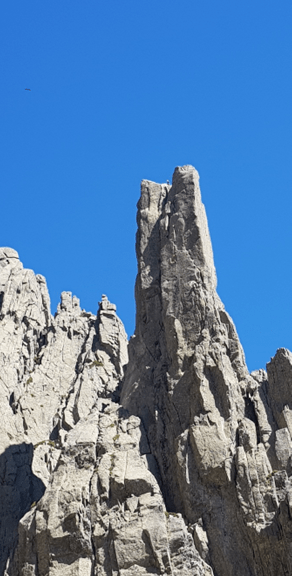This short article is to introduce “Sierra de Gredos” to the Colmcille Climbers.
In September 2024, I had the pleasure of spending two weeks in Sierra de Gredos, a mountain range two hour drive west of Madrid. My companions were Mourne-based climbers Kevin Quinn and Joe Rogan that I climb with at Hotrock and-the Mournes. Kevin has vast experience mountaineering in Ireland, Europe and the greater ranges. Joe also has years of experience, and is always stoked to climb, indoors or on granite slabs throughout the Mournes.
The Gredos are part of the Sistema Central Mountain range that continues north of Madrid up through central Spain. The range is primarily granite rock with some black shale around Los Galayos; one of the 4 locations we visited. The region has a wide variety of mountaineering opportunities including low level walks starting in villages, multiday refugio hikes, arrêtes scrambles, steep sports climbing, and our preference, multipitch trad climbing. All the guidebooks and information are in Spanish, however there are videos of climbs on YouTube and some sources are linked at the end. We were based outside the town of Arenas de San Pedro in a chalet-bungalow as part of a caravan-campsite, Camping Prados Abiertos. It is about a two-hour drive from Madrid airport. This sizable town has a tourist office near the castle, and this is another possible base having a selection of bars and restaurants.

Over the fortnight we visited all four climbing areas: Villarejo, El Torozo (number 2 on map), Los Galayos(14) and Circo de Gredos (3 and 23) which I have described in detail below. Having a car is essential as there is virtually no public transport.
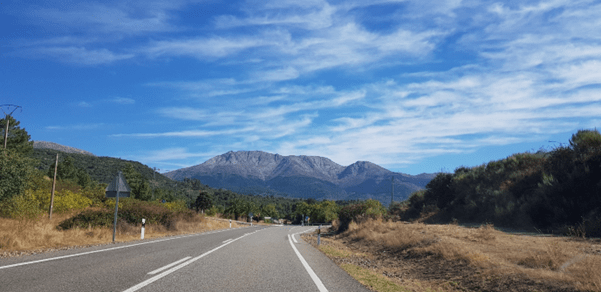
Villarejo
The first two days were spent at Villarejo, a big granite mountain with many walls. Most face southwest, with 170 routes from 15m to 200m up to Spanish 7c but many in the 4+ to 5+ grades. The 40-minute walk-in took us to some single pitch routes 30m in height and grades V to V+ with some 6a moves. The belays are equipped with rings and there is an odd bolt if there is no natural protection for steep sections. On the second day we tackled a 3-pitch route, Irene Castilla. Kevin climbed the first pitch in the afternoon sun, I followed up a rather blocky pitch, getting my first bit of exposure and then Joe led the pumpy V+ step onto a lovely slab pitch to finish. Arriving at the summit, vistas opened onto the walls behind with routes up very steep looking faces at apparently modest grades.
On our third visit to Villarejo, Kevin pointed us towards a 7 pitch “classic” (trad) 4-star route called Estaban Altieri, 180m of IV, V and V+ with a 6a option on the fifth pitch. Estaban Altieri meanders up the face and where routes cross over the correct belay is identified by the route name stamped on the bolts- how civilized! The forecast was a high of 25C in the afternoon so there was a risk we would get baked like sun-dried tomatoes if we were too lax on early pitches. Again, local climbers helped us find the start of the route, it seemed like they had all climbed it. Kevin led the third pitch. With route finding, it was a bit more serious than previous V pitches. The fourth pitch, a V+ with several bolts, was my lead but I was a bit pumped and offered it to Joe. He overcame issues with route finding, often looking for the rock with the least lichen.

We had reached a belay at a big junction of several routes and the possibility of escape by short abseil to the right. We had lunch and with a bit of high-level cloud protecting us from the sun we didn’t even discuss the opt out.
Kevin, standing boldly on a block above the belay, identified that the 6a option directly above was not preferred and moved out on a traverse to the right, then up. Meanwhile another Spanish escaladore did opt for the 6a. He clipped the bolts at the belay and trapped my rope. This meant I had to climb the direct 6a line and to free my rope from behind his at the bolts. It was very steep with no positive hand holds so I ascended using the quick draws. Joe easily led the next pitch(six), a V+ slab with a traverse on sparse gear. The guidebooks give a technical grade with no indication of other factors such as protection! I led the seventh pitch (IV-) which turned out to be a high-level scramble to the summit tor. Small rock cairns indicated the way to scramble down to an abseil. An hour later we were back in the car enjoying delicious ripe peaches.
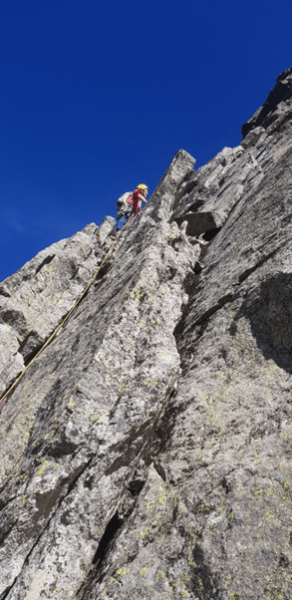
El Torozo.
We tackled a 5-pitch route, El grand Deidre on El Torozo, a mountain west of Villarejo but part of the same massif. Our strategy was to start early and avoid the sun-dried tomato risk. Arriving at the base after a forty-minute walk-in, we heard English being spoken. They were Ester and Scott from British Columbia- the only native English speakers we met during our trip. El grand Deidre was heaven. Dry, clean granite, pitch after pitch. It had a combination of trad protection and in-situ rings at the belay, with beautiful views down the Cinco villas valley. The Spanish climbers around us were friendly, offering beta on the route and other crags- their English being very much better than our pidgin Spanish.
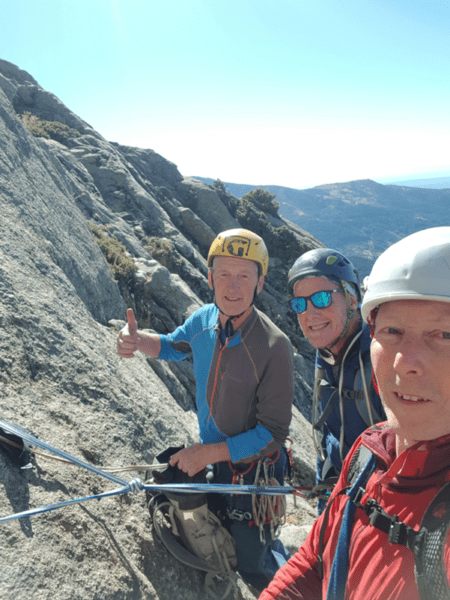
Another day Joe and I tackled an easy ridge that Kevin had climbed previously. We set off from the road at dawn- again to avoid the heat in the afternoon. There was some discussion about what gear to take. It was described as a slab scramble with a grade 4 step. Opting for a cautious approach we racked up at the bottom- harnesses and rock shoes on and alpine coils. The first slabs were easy-angled which Joe, being well used to granite just walked up. I was not so confident and sought out small edges, of which there were plenty. The step was easy, not as bold as the first move on the Mauvais Pas on “FM” so we put the rope away and enjoyed the friction on the granite. The sun was out but the cool wind meant we had to layer up and sought the shelter of a boulder cave to have a second breakfast(10.30am). The last section is a series of big blocks which present down climbing and route-finding challenges. We enjoyed spectacular views from the summit, especially across to our previous high point on El Torozo.
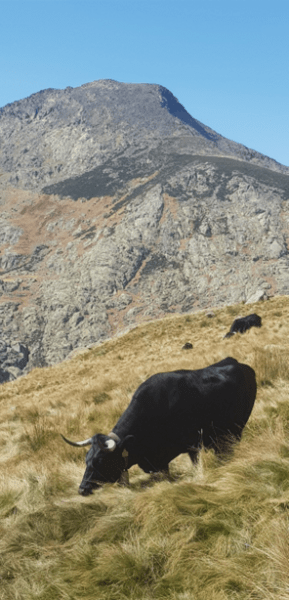
Los Galayos y La Mira.
The walk to Los Galayos is 2+hrs so it’s best to stay a few days in or around the hut, but our schedule didn’t allow it. Our plan was to walk in, climb El Torreon via a route on the south face and return to the car. We started with head torches before 7am. Two and a half hours later we arrived at Refugio Victory. It’s a basic hut with a guardian, a basic menu, floor space on the loft, water outside and no toilets. El Torreon is an obvious needle spike in the jaggy Los Galayos ridge on the right wall of the gorge. Kevin asked a local climber that had bivouacked beside the hut “Would it be too hot on the south face?” The reply “Not for Spanish but I can’t say for you”. Considering my hips were complaining, the exposure on the summit, the possible heat on the face, I opted out of the climb. After taking some photos, I headed off up a scree path to La Mira (2343m) on the plateau. There are views back east to Torozo and Villarejo and west to the Circo de Gredos. Arriving at the summit tower, a mother goat came to investigate if I would offer any scraps for lunch. A family of Golden Eagles cast shadows on the plateau and Alpine choughs were screaming about the cliffs.
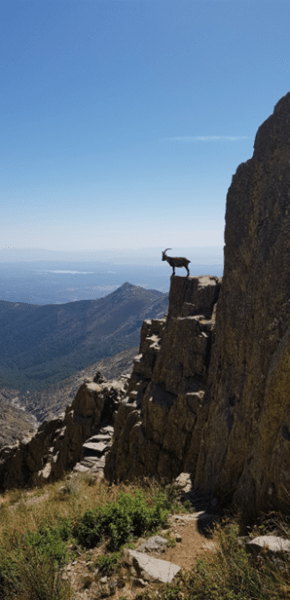
Javier is the current hut guardian, also a mountain guide, he speaks incredibly good English. Leaving the hut after a coffee, I heard familiar but distant voices. Looking up I saw Kevin’s yellow helmet on the top of El Torreon. They had made it! Back at the car park, locals advised that a dip in the spring fed trough was part of the experience. Walk, swim and then beer!
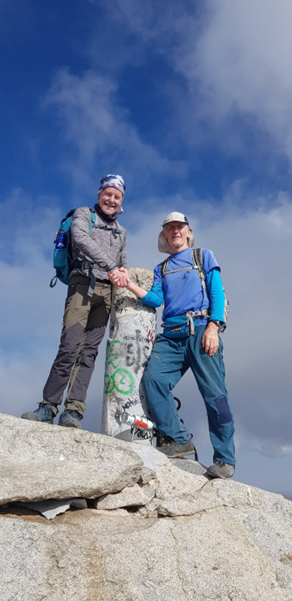
La Laguna Grande y El Amanzor (2592m)
In the afternoon we walked from the road end car park at “La platforma” to Refugio Elola (1970m)-booking necessary. The walk took us past upland pastures with horned black cows with massive bells. This fully serviced mountain hut uses the endemic, and extremely rare, Almanzor fire salamander which is black with yellow dots as its logo.
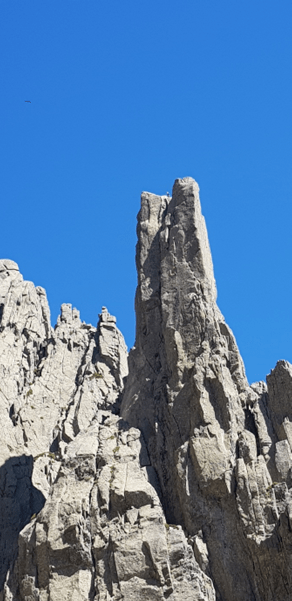
The Circo de Gredos is a rocky ridge reminiscent of the Cuillin Ridge on Skye. To reach the summit of Almanzor from the hut takes 2.5 hours of walking and scrambling. The route to the summit involves a scramble with a grade 3 step but no need for equipment. We found our way along the ridge by following the worn rock and picking out the next small cairn in the rocky terrain. For those interested, it is known as a winter destination with a microclimate of alpine conditions for most of the winter.
After a long descent back to the car park. It was an hour’s drive back to the campsite, so we opted for a meal in the village of Hoyos del Espino. This is a substantive town with several hotels and apartments, so it is a possible base for exploring the high valleys from the north.
Sports craigs.
On lazy days we visited 2 sports crags with single pitch bolted climbs to the north of the range, so an hour or so from our base. We also explored several “pozas”, pools in rivers which are either natural pools, or dammed during the summer months for swimming. One in Arenas de San Pedro is a full-sized pool, equipped with ladders and lawn for sunbathing- unfortunately they drained it for the winter the week after we arrived!

I really enjoyed the two weeks. Thanks to Kevin for the introduction to the range and showcasing the major features for Joe and me. I bought maps and guidebooks for a return trip.
Hugh McCann May 2025
Newcastle. County Down.
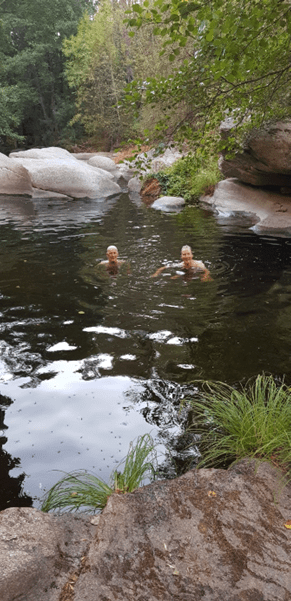
Here are some links which allow for more exploration.
Sierra de Gredos Regional Park | Fascinating Spain
www.turismoarenas.es and email turismo@aytoarenas.es
✅ Bienvenidos al Camping Prados Abiertos al sur de la Sierra de Gredos.
ReservationsLaguna Grande Refuge (refugiolagunagrandegredos.es)
Almanzor Fire Salamander | Citizen Conservation (citizen-conservation.org)
www.Desnivel.com is a publishing source for this region. Eg of guides
https://www.desnivel.com/librosdesnivel/senderos-de-gredos-30-excursiones-y-ascensiones-clasicas/
https://www.libreriadesnivel.com/libros/sierra-de-gredos-guia-de-escalada/9788498292848/
https://www.libreriadesnivel.com/libros/albujea-y-torozo/9788461737420/
https://www.libreriadesnivel.com/libros/riscos-de-villarejo/9788461616350/ and maps
https://www.libreriadesnivel.com/mapas/parque-regional-de-la-sierra-de-gredos/1202/
Example videos/blogs with routes and photos.
Amuso: Alto de los Corralillos y Torozo desde el Puerto del Pico (Gredos)
Torozo, Gran Diedro. V+, 220 m. D+ – Entre la Tierra y el Cielo – as text above.
https://youtu.be/GreYRz0J4RM?si=wLrZGCG9CjANFFmm
Amuso: Riscos de Villarejo. Punta Amparo: Irene Castilla (110m, V+) good intro to Villarejo
Amuso: La Mira desde Nogal del Barranco (Gredos) for walk in to Los Gredos.
Amuso: Almanzor desde la Plataforma de Gredos (Portilla del Crampón – Portilla de los Cobardes)

